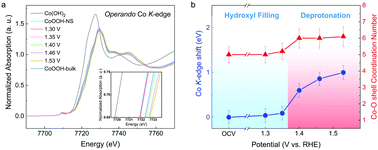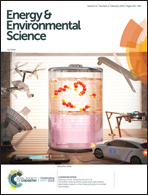Electrochemically accessing ultrathin Co (oxy)-hydroxide nanosheets and operando identifying their active phase for the oxygen evolution reaction†
Abstract
Cobalt (oxy)-hydroxide (CoOOH) has recently been identified as a realistic active species under operando conditions for the electrocatalytic oxygen evolution reaction (OER), which plays a pivotal role in multiple energy conversion technologies. Therefore, searching for a high-yield method to fabricate advanced nanostructures and understanding their reactivity are challenging but urgent tasks. Here, rather than conventional liquid exfoliation, we report an electrochemical route for potentially large-scale production of ultrathin CoOOH nanosheets, which deliver exceptionally high OER activity. This “nearly-all-surface” material provides an excellent platform to study the surface chemistry for electrocatalytic activity. Combining operando X-ray spectroscopy and theoretical calculations demonstrated a potential-dependent deprotonation reaction, i.e., Co3+OOH is transformed into an active Co3+/4+OOH1−x phase for water oxidation under the applied potential. Comprehensive analysis suggested that reducing the deprotonation energy is the key to enhance the OER activity, and oxidized oxygen ions might act as electrophilic centers for the OER.



 Please wait while we load your content...
Please wait while we load your content...